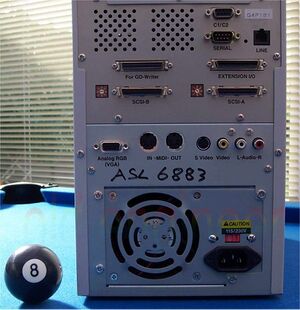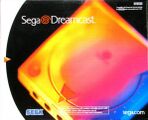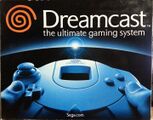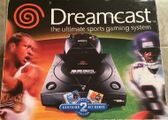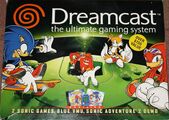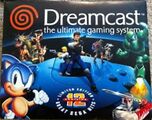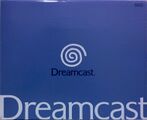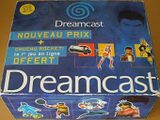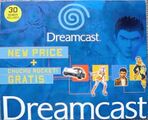Difference between revisions of "Sega Dreamcast"
From Sega Retro
(→Physical Scans: one day I'll find a perfect solution) |
|||
| Line 247: | Line 247: | ||
==Physical Scans== | ==Physical Scans== | ||
| − | + | {{Scanbox | |
| − | + | | console=Dreamcast | |
| − | + | | region=US (older) | |
| − | + | | front=Dreamcast US Box Front.jpg | |
| + | | back= | ||
| + | | disc= | ||
| + | }}{{Scanbox | ||
| + | | console=Dreamcast | ||
| + | | region=US (newer) | ||
| + | | front=DC US Box Front Newer.jpg | ||
| + | | back= | ||
| + | | disc= | ||
| + | }}{{Scanbox | ||
| + | | console=Dreamcast | ||
| + | | region=US (Sega Sports) | ||
| + | | front=DC US Box Front SegaSports.jpg | ||
| + | | back= | ||
| + | | disc= | ||
| + | }}{{Scanbox | ||
| + | | console=Dreamcast | ||
| + | | region=US (Sonic) | ||
| + | | front=DC US Box Front Sonic.jpg | ||
| + | | back= | ||
| + | | disc= | ||
| + | }}{{Scanbox | ||
| + | | console=Dreamcast | ||
| + | | region=US (''[[Sega Smash Pack]]'') | ||
| + | | front=DC US Box Front SSP.jpg | ||
| + | | back= | ||
| + | | disc= | ||
| + | }}{{Scanbox | ||
| + | | console=Dreamcast | ||
| + | | region=EU | ||
| + | | front=DC EU Box Front.jpg | ||
| + | | back= | ||
| + | | disc= | ||
| + | }}{{Scanbox | ||
| + | | console=Dreamcast | ||
| + | | region=JP | ||
| + | | front=DC JP Box Front.jpg | ||
| + | | back= | ||
| + | | disc= | ||
| + | }}{{Scanbox | ||
| + | | console=Dreamcast | ||
| + | | region=FR (''[[ChuChu Rocket!]]'') | ||
| + | | front=DC FR Box Front ChuChuRocket.jpg | ||
| + | | back= | ||
| + | | disc= | ||
| + | }}{{Scanbox | ||
| + | | console=Dreamcast | ||
| + | | region=ES (''[[ChuChu Rocket!]]'') | ||
| + | | front=DC ES Box Front ChuChuRocket.jpg | ||
| + | | back= | ||
| + | | disc= | ||
| + | }} | ||
{{Sega_Consoles}} | {{Sega_Consoles}} | ||
{{Dreamcast}} | {{Dreamcast}} | ||
[[Category:Sega Dreamcast| ]] | [[Category:Sega Dreamcast| ]] | ||
Revision as of 07:04, 20 May 2012
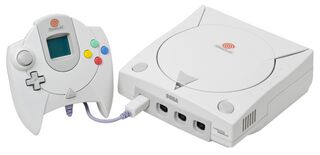
| |||||
| Sega Dreamcast | |||||
|---|---|---|---|---|---|
| Manufacturer: Sega | |||||
| Variants: List of special release models | |||||
| Add-ons: Dreameye, Dreamcast Karaoke | |||||
|
The Sega Dreamcast (ドリームキャスト), code-named "Katana" and "Dural" during development, is a video game console manufactured by Sega as a successor to the Sega Saturn. It was the first machine released in what is now known as the sixth generation of video game consoles, with its sixth-generation peers being the Sony PlayStation 2, the Nintendo GameCube and the Microsoft Xbox.
The Dreamcast was Sega's last home console, and developed primarily to detoxify the Sega brand. Western trust in Sega had been reduced following the dismal performance of the Sega Mega CD, Sega 32X and Sega Saturn, and Sega were keen to regain the trust seen in the days of the Sega Mega Drive. Faced with increased competition from Sony, Nintendo and Microsoft, the Dreamcast landed in a distant fourth place, and Sega largely pulled out of the console business as a result. However, the innovative features of the Dreamcast along with a strong library of games means the console still has a large, dedicated fanbase, to the extent that Dreamcast games are still being released commercially today.
One of the main features of the Dreamcast aside from cutting edge graphics for 1998/1999, is the built-in 56K modem. This gives users access to the Internet for web browsing, chat, email and (perhaps most importantly) online gaming. It was the first console to offer online features straight out of the box, and the first to offer these features worldwide, rather than in select markets.
Contents
Development
- Main article: Sega Dreamcast Development
In 1996, rumours of a next generation Sega game console started to surface. According to the rumours, the machine's development title was 'Dural', named after a character from Sega AM2's Virtua Fighter series. In early 1997, insiders told of two new developments - Sega and Microsoft were in discussions and NEC/Videologic had been approached with regard to the graphics chipset.
Soon after, 3DFX, the graphics technology company, revealed a deal with Sega to provide technology for a new machine codenamed 'BlackBelt'. At the time, 3DFX produced the popular PC graphics accelerator chipset, the Voodoo, and it was this chipset that was allegedly going to be used in Sega's new machine.
At this point it became clear that Sega actually had two different machines in development, one in Japan (development names Dural/Katana (a katana is a type of sword)), and one in America (development name BlackBelt), both being worked on independantly from one another. At one stage the BlackBelt, jointly developed by SegaSoft, Microsoft and 3DFX, was shown to a limited number of developers and was apparently very well received. The OS was designed to make the machine easy to develop for and allowed for quick conversions of games to and from the PC. At the time Sega's policy seemed to suggest that raw processing power wasn't as important as an easy to develop for operating system - the Saturn reportedly was very difficult for developers to use, and it seemed logical to rectify this.
The Japanese Katana system generally outperformed the BlackBelt in hardware terms, but had a more intricate and difficult operating system. The Japanese view of the video game market was still very different from its western counterpart - the Saturn had been successful in Japan, and there was less of a demand to radically change business practise in that region.
In July, Sega cancelled the 3DFX deal and it soon became apparent that the Blackbelt had been dropped too. It is unknown exactly why the BlackBelt was dropped in favour of the Japanese design, but the most likely reason is that the production cost would have been higher, ultimately leading to a more expensive final street price. Another possibility is that the 'BlackBelt' just wasn't powerful enough to compete in a market with other next generation machines from companies like Sony.
Shortly afterwards it was officially announced that Hitachi would be making the CPU for the Kitana machine, and in early 1998, NEC/Videologic was finally confirmed to be providing the new graphics chipset, the PowerVR Series II. The operating system was tweaked to make it as easy to use and develop for as BlackBelt was going to be, however Microsoft wrote another development system, based on its Windows CE technologies.
Microsoft decided to cooperate with Sega in an attempt to promote its Windows CE operating system for video games, but Windows CE for the Dreamcast showed very limited capabilities when compared to the Dreamcast's native operating system. The libraries that Sega offered gave room for much more performance, but they were sometimes more difficult to utilize when porting over existing PC applications.
In May 1998 the Dreamcast was officially announced by Bernie Stolar, then CEO of Sega of America.
In the July 1998 edition of the UK's Sega Saturn Magazine, the then-CEO of Sega of Japan, Shoichiro Irimajiri, outlined his vision of how the Dreamcast would perform. It was fully expected that by 2000 superior hardware would have likely been released into the market, but that the Dreamcast would be the console to go for when it came to games. Interestingly music was highlighted as being one of the Dreamcast's strengths, which may explain the emergence of teams such as Wave Master. Many games were set to span multiple genres - perhaps later realised by the likes of Space Channel 5 or Rez.
It was estimated that $500 million USD was pumped into the Dreamcast's launch.
Logo
Shoichiro Irimajiri claimed the Dreamcast's logo is supposed to symbolise the "origin of power", with the universe being "like a vortex".
The Sega Dreamcast has a red/orange spiral as its logo in all regions apart from Europe (and Australia) where it was changed to blue. It is suspected that this was due to a German educational game publishing company "Tivola" using a similar orange swirl in their logo. Though the color scheme was changed for all European games, advertisements and media, the orange LED used in the console was not replaced with a blue one. Many third-party accessories also continued to use orange/white packaging.
Release
Japan
The Dreamcast was first released on the 27th of November 1998 in Japan with four launch titles: July, Pen Pen TriIcelon, Virtua Fighter 3tb, and Godzilla Generations. The situation in Japan was very different to that of the western world - in Japan the Sega Saturn had been a rousing success, and Japanese publishers failed to see the need for a new console. However sales were still strong for many years and Sega of Japan's position was to run the two consoles in parallel, with the possibility of the Saturn handling 2D games, and the Dreamcast, 3D.
Initial predictions by Sega were that the Sony PlayStation 2 would debut in late 1999 (it was actually early 2000 in Japan). The aim was to attract as many developers as possible within a year to attempt to secure the Dreamcast as the number one consoles of its generation.
With the Mega Drive, Sega had identified the US and Europe as the largest video game markets. With the Saturn and Dreamcast, they felt (perhaps wrongly) that Japan was the key territory. As such, like the Saturn, the Dreamcast was subjected to many games exclusive to Japan, along with numerous exclusive peripherals and special Dreamcast models.
Japanese Dreamcasts can be identified by the triangle at the front of the unit. Though the power LED is identical across all regions, the piece of plastic attached to the lid of the Japanese model is transparent, while in North America it is grey.
North America
The US had to wait nearly a full year for their Dreamcasts - Sega executed a massive launch on the 9th of September 1999 (9/9/99). Shoichiro Irimajiri claimed this was so the Dreamcast could launch with wider variety of games (it ended up being 4 (JP) vs. 18 (US)), and the first time a Sega console would launch with "enough" games.
The Dreamcast took in over $97 Million USD on the first day of launch in North America, and sold over 500,000 machines in the first two weeks. Sega were quick to point out that $97,000,000 is more than Star Wars: The Phantom Menace brought in on its first day of release. Over a million machines were sold in North America in just over two and a half months, making the Dreamcast the fastest selling video games machine in that region, ever.
Sega Dreamcast's motto in the US was "It's thinking". There was some confusion with Sega's marketing tactics at the time, as adverts often failed to address what was thinking. It was not always clear that the Dreamcast was a games console.
But the Dreamcast was met with problems when rumours of Sony's PlayStation 2 came into circulation. Many consumers held back from buying Dreamcasts, anticipating that Sony's console would be superior. Predictably, the PlayStation 2 proved to be a more capable machine, and despite its relatively weak initial library of games, came out on top due to the inclusion of DVD-playback capabilities. At the time, DVD players were quite expensive, so the PS2 was seen as a much better deal.
Production of North American Dreamcasts ceased in 2001, after Sega announced plans to leave the console business. Despite this, the Dreamcast is seen to have been more successful than the Sega Saturn (and Sega Master System) in this region.
Europe
The European release date was also aimed at a 9/9/99 release date but was pushed back to the 14th of October 1999. Likewise, initial European sales figures looked healthy, with over 100,000 machines sold in Europe on launch day alone and over 185,000 in the first weekend, but were console was threatened by the release of the PlayStation 2 and inevitably suffered the same fate as its North American counterpart.
On 8 September 2000, Sega Europe reduced the price in the UK to £149.99. [1]
Australia/New Zealand
Unfortunately, in the Australian region the launch was less successful, often being labeled a disaster by fans of Sega. Ozisoft, the official Sega distributor in Australia, only managed to output nine launch titles despite the late release date (November 30, 1999), none of which were first party products. Apparently Sega-developed software had been held in customs and could not reach store shelves by the release deate. Also with no VMUs or other peripherals on the market, it seemed that after what seemed like infinite delays, Australian fans deserved better.
Brazil
Tectoy, who had been responsible for distributing Sega consoles in Brazil since the Sega Master System, brought the Dreamcast to Brazil in 1999. The majority of games were repackaged titles imported from the US, and the console was not particularly successful.
South Korea
Dreamcast was intended to be released through Hyundai, unlike all the other previous Sega Installment, which went through Samsung. All the model was converted into 220v and they came with modem cables. It was released after the release of Xbox and Ps2. They first shipped 25000 Dreamcasts. It was low priced comparing to other consoles. However, they have cancelled the release of Dreamcast at the last second for unknown reasons.
About the Console
The Dreamcast used a proprietary format of storage called GD-ROMs for games in order to foil software pirates, a strategy that ultimately backfired when the first run of discs had a high rate of defects. The format was also cracked fairly quickly (and in some cases, the pirated games were released before the legitimate versions). Sega largely had themselves to blame for the high levels of Dreamcast piracy—their use of the GD-ROM format was completely undermined by the console's support for the Mil-CD format, which allowed the console to boot from a standard CD-R. Mil-CD support was removed from the final Dreamcast revisions toward the end of the console's life.
The GD-ROM format also put the console at a disadvantage when competing against the Sony PlayStation 2 - the PS2 used DVDs, and could therefore run DVD videos making it an inexpensive DVD player as well as a video game console. DVD-ROMs also have more stoage space, allowing for bigger games (though the initial run of PS2 games used a blue CD-ROM format).
The Dreamcast was the first video game console to ship with a built-in 56k modem, with broadband adapters being made available later on in certain regions. This allowed the system to connect to the internet using a custom, fully-functional web browser and e-mail client. Many games released for the Dreamcast shipped with online play modes, the most popular being Phantasy Star Online and the Sega Sports lineup (now published under the ESPN label). Although other consoles before the Dreamcast had network gaming support, such as the Sega Saturn's NetLink and the Sega Mega Drive's XB∀ND, the Dreamcast was the first game console to include this ability out of the box and is therefore considered the first internet-enabled home game system.
The Dreamcast has a modest hacking enthusiast community. The availability of Windows CE software development kits on the Internet—as well as ports of Linux (LinuxDC) and dreamcast NetBSD operating systems to the Dreamcast—gave programmers a selection of familiar development tools to work with, even though they do not really support the high speed graphics. A homebrew minimal operating system called Kallistios offers support for most hardware, while not offering multi-tasking, which is superfluous for games. Many emulators and other tools (MP3, DivX players, and image viewers) have been ported to or written for the console, taking advantage of the relative ease with which a home user can write a CD which is bootable by an unmodified Dreamcast.
Sega released a board, using the same technology as the Dreamcast, called Sega NAOMI for use in arcades, leading to many Dreamcast-exclusive games with a high level of arcade quality. They later packaged the Dreamcast into an arcade board as the Sammy Atomiswave.
Though the Dreamcast was officially discontinued in early 2001, commercial games were still developed for it and worldwide software support continued until 2002, terminating in the USA with the February 12th release of NHL 2K2, and in Europe with Cannon Spike and Freestyle Scooter on May 3. In Japan, software support continued for much longer. On February 24, 2004, Sega released its final Dreamcast game, Puyo Puyo Fever. The final new third party game for the system was Karous, released on March 8, 2007, and the final official release was a reprint of the 2003 title Border Down released exclusively through the Messe Sanoh store on January 17, 2008.
Hardware
What's in the box?
You will normally find the following in your box, along with a bunch of advertising-based and warning pamphlets together with recycled and recyclable packaging materials.
- The Dreamcast console
- Modem (attached to the console, but detachable - try it!)†
- One joypad controller
- Demo GD-ROM Disc
- Browser Disc ††
- A long (30 foot) phone cable for the modem†
- Power cable with the appropriate plug for your region
- Composite video lead (also known as an AV cable)†††
- Manual (a simple black and white affair)
† If your machine is imported from Asia, or if you live there, you won't get a modem, just a lump of plastic so that you don't have a gaping hole in the side of your machine.
†† The exact browser disc included varied by region and time of release. The Japanese browser was Dream Passport, the US browser was PlanetWeb and the European browser was DreamKey.
††† In the UK, a RF Unit was included instead of the AV cable to ensure that the Dreamcast was compatible with all TV's. I don't have any info yet on which TV leads were included in other European regions, but it is possible that an RGB/SCART cable was included.
There is no VMU in the standard Dreamcast packages in any of the 4 regions.
There is no RF unit in the standard North American Dreamcast package. For older TV's, you'll have to purchase this separately. Also, if you have a S-Video or SCART capable TV, you should buy the relevant cable for that too. erman company holding a trademark on the distinctive orange swirl present on American and Japanese Dreamcasts. The system power light remains the orange color is on foreign Dreamcasts, however.
Special Dreamcasts
For a full list of special edition dreamcasts, see Special Dreamcast Models.
Specifications
- CPU: SH-4 RISC CPU with 128 Bit graphic computational engine built-in (operating frequency: 206 MHz 360 MIPS/1.4 GFLOPS)
- GPU: PowerVR2 CLX2*
- It is capable of drawing around 7 million polygons per second, but the geometry data storage (the models for the polygons) would become a limiting factor, chipping away video memory for the textures.
- Color Output: Approx. 16.77 million simultaneous colors (24 bit)
- Memory: Main 16 MB (Hyundai HY57V161610D), Video 8 MB, Sound 2 MB
- Sound Card: Super Intelligent (Yamaha) Sound Processor with 47MHz 32-Bit RISC [ARM7 CPU core built-in (64 channel PCM/ADPCM)
- GD-ROM Drive: 12x maximum speed (when running in Constant Angular Velocity mode)
- Inputs: Four ports that can support a digital and analog controller, steering wheel, joystick, keyboard, mouse, and more
- Dimensions: 189mm x 195mm x 76mm (7 7/16" x 7 11/16" x 3")
- Weight: 1.9kg (4.4lbs)
- Modem: Removable; Original Asia/Japan model had a 33.6 Kbytes/s; models released after 9 September 1999 had a 56 Kbytes/s modem
- Sega Dreamcast Broadband Adapter: these adapters are available separately and replace the removable modem
- HIT-400: "Broadband Adapter", the more common model, this used a RealTek 8139 chip and supported 10/100mbit
- HIT-300: "Lan Adapter", this version used a Fujitsu MB86967 chip and supported only 10mbit
- Storage: "Visual Memory Unit" (VMU) 128 Kb removable storage device
- Input devices: (4 custom controller ports)
- Standard Dreamcast gamepad with two add-on ports
- Add-ons: VMU, 4x Memory Card, Jump Pack
- Sega Dreamcast Keyboard
- Sega Dreamcast Mouse
- Sega Dreamcast Fishing Controller
- Sega Dreamcast Microphone (bundled with Seaman)
- VMU MP3 Player (Unreleased)
- Swatch Access for Dreamcast (Unreleased)
- Standard Dreamcast gamepad with two add-on ports
- Output devices:
- Sega Dreamcast RF Unit
- Sega Dreamcast AV cables (composite)
- Sega Dreamcast VGA Adapter
- Add-ons:
- Sega Dreamcast Karaoke System (Japan only)
- Dreameye (Japan only)
- Sega Dreamcast Zip Drive (Unreleased)
BIOS
| BIOS Version | Machine | Download |
|---|---|---|
| 1.004 | Sega Dreamcast (Commercial-Early) | 1.004 (Japan) (info) ("Jp_dc_1.004.7z" does not exist) |
| 1.01d | Sega Dreamcast (Commercial) | 1.01d (North America) (info) ("Us_dc_1.01d.zip" does not exist) |
| 1.01d (Europe) (info) ("Eu_dc_1.01d.zip" does not exist) | ||
| 1.01d (Japan) (info) ("Jp_dc_1.01d.zip" does not exist) | ||
| 1.011 | Sega Dreamcast (HKT-0120 Devbox) | 1.011 (HKT-0120 Devbox) (info) ("Jp_dc_1.011(dev).7z" does not exist) |
Launch Titles
Japan
North America
Europe
Gallery
Photos
Hardware Diagrams
Physical Scans
| Dreamcast, US (Sega Smash Pack) |
|---|
| Dreamcast, JP |
|---|
| <div style="margin:auto; max-width:Expression error: Unexpected < operator.px">
320x120px Cover
|
| Dreamcast, FR (ChuChu Rocket!) |
|---|
| Dreamcast, ES (ChuChu Rocket!) |
|---|
| Sega Home Video Game Systems | ||||||||||||||||||||||||||||
| 83 | 84 | 85 | 86 | 87 | 88 | 89 | 90 | 91 | 92 | 93 | 94 | 95 | 96 | 97 | 98 | 99 | 00 | 01 | 02 | 03 | 04 | 05 | 06 | 07 | 08 | 09 | 10 | 11 |
|---|---|---|---|---|---|---|---|---|---|---|---|---|---|---|---|---|---|---|---|---|---|---|---|---|---|---|---|---|
| SG-1000 | SG-1000 II | Mega Drive | Mega Drive II | |||||||||||||||||||||||||
| SC-3000 | Mega-CD | Mega-CD II | Genesis 3 | |||||||||||||||||||||||||
| Sega Mark III | 32X | Dreamcast | ||||||||||||||||||||||||||
| Master System | Master System II | |||||||||||||||||||||||||||
| AI Computer | Game Gear | |||||||||||||||||||||||||||
| Saturn | ||||||||||||||||||||||||||||
| Pico | Beena | |||||||||||||||||||||||||||

